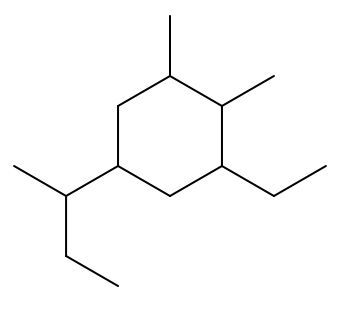- Download the worksheet to save time writing
- Start solving the practice problems
- If you're stuck, watch the video solutions
- See your summary to get more insights

Determine which molecule has:
(i) a higher density between hexane and nonane.
(ii) a higher boiling point between tert-butyl alcohol and tert-butylamine.
(iii) a lower boiling point between octylamine or di-tert-butylamine.
Explain the difference in boiling points in the following pairs of compounds:
i. The boiling point of ethanol (78 °C) is lower than methanediol (192 °C).
ii. The boiling point of ethanamine (17°C) is lower than ethanol (78 °C).
Among the compounds in the table below, identify the largest alkane, the largest terminal alkene, and the largest terminal alkyne that are gases at room temperature.

Determine which compound is more soluble in water for each of the following pairs: (i): cyclohexane or tetrahydro-2H-pyran and (ii): tetrahydrofuran or 1,3-dioxolane. Explain.

A. (i): Tetrahydro-2H-pyran is more soluble than cyclohexane because it can form stronger intermolecular interactions (hydrogen bonding) with water molecules; (ii): 1,3-dioxolane is more soluble than tetrahydrofuran because it can form more hydrogen bonding per molecule with water than tetrahydrofuran.
B. (i): Tetrahydro-2H-pyran is more soluble than cyclohexane because it can form covalent bonds with water molecules; (ii): 1,3-dioxolane is more soluble than tetrahydrofuran because it can form more covalent bonds per molecule with water than tetrahydrofuran.
C. (i): Cyclohexane is more soluble than tetrahydro-2H-pyran because water and cyclohexane are both non-polar molecules; (ii): Tetrahydrofuran is more soluble than 1,3-dioxolane because it can form more hydrophobic interactions with water molecules.
D. (i): Cyclohexane is more soluble than tetrahydro-2H-pyran because it can form covalent bonds with water molecules; (ii): Tetrahydrofuran is more soluble than 1,3-dioxolane because it can form more covalent bonds per molecule with water.
Indicate whether the compound below is hydrophilic, hydrophobic, lipophilic, or lipophobic.

Determine which compound is soluble in water and which is more soluble in a nonpolar solvent.

The indicated carbon atoms comprise the ether functional group in the compounds below. Determine the degrees of these carbons.

Answer the following questions on alkanes:
(i) How many carbons does an alkane have if it contains 52 hydrogens?
(ii) How many hydrogens does an alkane have if it contains 15 carbons?
Answer the following questions about the given compound:
(i) How many primary carbons does it have?
(ii) How many secondary carbons does it have?
(iii) How many tertiary carbons does it have?
An alkyl group with four carbons can exist in four different forms. Draw these alkyl groups to identify the degree of substitution as primary (1°), secondary (2°), or tertiary (3°), of the head carbon atom.
